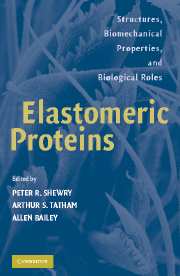Book contents
- Frontmatter
- Contents
- Preface
- Contributors
- Elastomeric Proteins
- 1 Functions of Elastomeric Proteins in Animals
- 2 Elastic Proteins: Biological Roles and Mechanical Properties
- 3 Elastin as a Self-Assembling Biomaterial
- 4 Ideal Protein Elasticity: The Elastin Models
- 5 Fibrillin: From Microfibril Assembly to Biomechanical Function
- 6 Spinning an Elastic Ribbon of Spider Silk
- 7 Sequences, Structures, and Properties of Spider Silks
- 8 The Nature of Some Spiders' Silks
- 9 Collagen: Hierarchical Structure and Viscoelastic Properties of Tendon
- 10 Collagens with Elastin- and Silk-like Domains
- 11 Conformational Compliance of Spectrins in Membrane Deformation, Morphogenesis, and Signalling
- 12 Giant Protein Titin: Structural and Functional Aspects
- 13 Structure and Function of Resilin
- 14 Gluten, the Elastomeric Protein of Wheat Seeds
- 15 Biological Liquid Crystal Elastomers
- 16 Restraining Cross-Links in Elastomeric Proteins
- 17 Comparative Structures and Properties of Elastic Proteins
- 18 Mechanical Applications of Elastomeric Proteins – A Biomimetic Approach
- 19 Biomimetics of Elastomeric Proteins in Medicine
- Index
Preface
Published online by Cambridge University Press: 13 August 2009
- Frontmatter
- Contents
- Preface
- Contributors
- Elastomeric Proteins
- 1 Functions of Elastomeric Proteins in Animals
- 2 Elastic Proteins: Biological Roles and Mechanical Properties
- 3 Elastin as a Self-Assembling Biomaterial
- 4 Ideal Protein Elasticity: The Elastin Models
- 5 Fibrillin: From Microfibril Assembly to Biomechanical Function
- 6 Spinning an Elastic Ribbon of Spider Silk
- 7 Sequences, Structures, and Properties of Spider Silks
- 8 The Nature of Some Spiders' Silks
- 9 Collagen: Hierarchical Structure and Viscoelastic Properties of Tendon
- 10 Collagens with Elastin- and Silk-like Domains
- 11 Conformational Compliance of Spectrins in Membrane Deformation, Morphogenesis, and Signalling
- 12 Giant Protein Titin: Structural and Functional Aspects
- 13 Structure and Function of Resilin
- 14 Gluten, the Elastomeric Protein of Wheat Seeds
- 15 Biological Liquid Crystal Elastomers
- 16 Restraining Cross-Links in Elastomeric Proteins
- 17 Comparative Structures and Properties of Elastic Proteins
- 18 Mechanical Applications of Elastomeric Proteins – A Biomimetic Approach
- 19 Biomimetics of Elastomeric Proteins in Medicine
- Index
Summary
Elastic proteins occur in a wide range of biological systems, from plants and invertebrates to humans, where they have evolved to fulfil precise functional roles. The majority of these proteins possess rubber-like elasticity, undergoing high deformation without rupture and then returning to their original state on removal of the stress, with virtually all the energy stored on deformation being returned. The second stage of this process is passive and does not require an input of energy. Such an entropic mechanism is ideal for elastomers that are required to last a long time (e.g., aortic elastin undergoes millions of stress-strain cycles in a human life span). However, not all biological protein elastomers have purely entropic mechanisms.
In simple terms, chains of a protein elastomer must be flexible and independently free to respond rapidly to an applied force and must also form a network of monomers stabilised by cross-links between non-elastic domains. The elasticity will therefore vary with the length of the flexible domain and the extent of cross-linking.
The best-known and most widely distributed protein elastomer is elastin, which is responsible for the elasticity of the aorta and skin of mammals, and is also present in the ligamentum nuchae which is involved in raising the heads of grazing hoofed animals. More recently, fibrillin, which forms the scaffold for elastin in vertebrate tissues, has also been shown to have elastic properties.
- Type
- Chapter
- Information
- Elastomeric ProteinsStructures, Biomechanical Properties, and Biological Roles, pp. vii - xPublisher: Cambridge University PressPrint publication year: 2003

